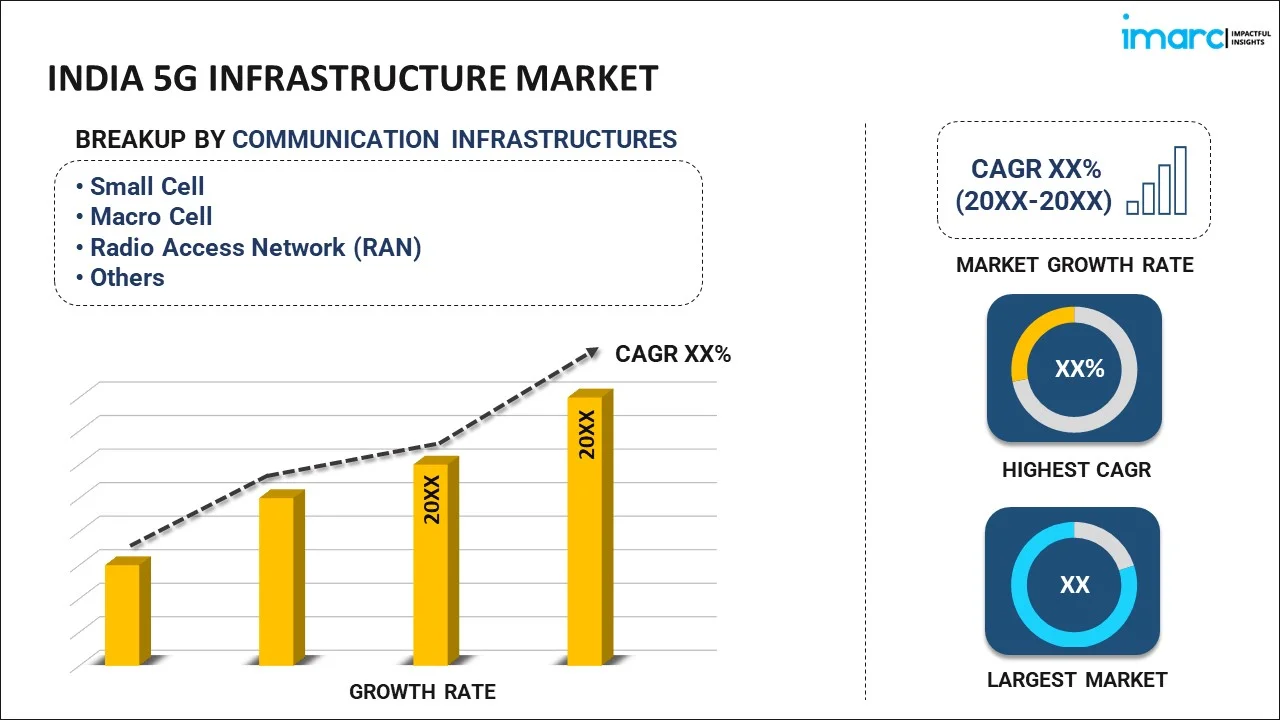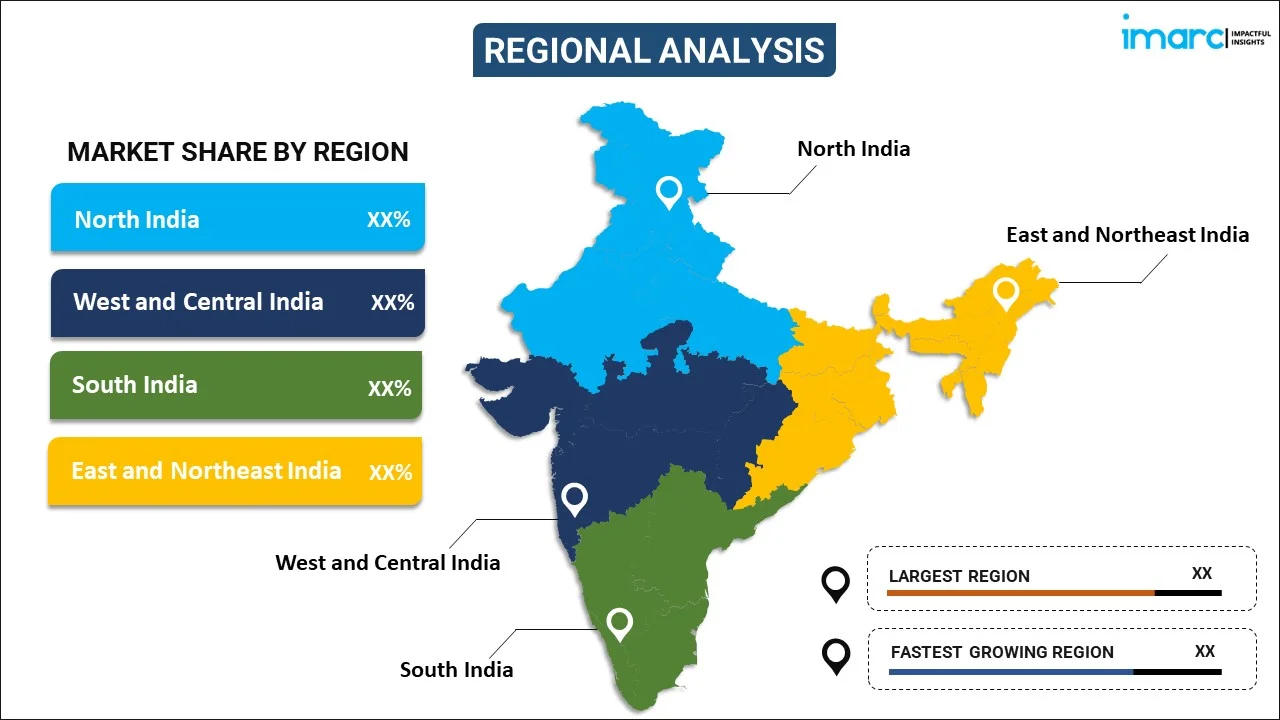
India 5G Infrastructure Market Report by Communication Infrastructure (Small Cell, Macro Cell, Radio Access Network (RAN), and Others), Network Technology (Software-Defined Networking, Network Function Virtualization, and Others), Network Architecture (Standalone, Non-Standalone), Frequency (Sub-6 Ghz, Above 6 Ghz), End User (Automotive, Energy and Utilities, Healthcare, Home User, and Others), and Region 2025-2033
Market Overview:
India 5G infrastructure market size reached USD 532.8 Million in 2024. Looking forward, IMARC Group expects the market to reach USD 14,751.0 Million by 2033, exhibiting a growth rate (CAGR) of 41.3% during 2025-2033. The ongoing innovations, economic development, and improved connectivity for businesses and individuals are primarily driving the market growth across the country.
|
Report Attribute
|
Key Statistics
|
|---|---|
|
Base Year
|
2024 |
|
Forecast Years
|
2025-2033 |
|
Historical Years
|
2019-2024
|
| Market Size in 2024 | USD 532.8 Million |
| Market Forecast in 2033 | USD 14,751.0 Million |
| Market Growth Rate (2025-2033) | 41.3% |
The 5G infrastructure encompasses the hardware, software, and services that facilitate the functioning of the fifth generation of mobile networks. This technology offers superior data download and upload speeds, more dependable connections, and reduced latency when compared to its predecessor, 4G. Notably, 5G ensures enhanced and more expansive network coverage, extending to remote and underserved areas. This advancement results in accelerated content streaming, swift data transfers, improved energy efficiency, leading to prolonged battery life for devices, and a diminished environmental impact. The applications of 5G extend to various sectors, including telemedicine, remote surgeries, and patient monitoring, benefiting from its higher data speeds. Furthermore, the integration of 5G in gaming and entertainment enhances the user experience due to the increased data speeds. The technology also plays a pivotal role in autonomous vehicles, contributing to safer and more efficient driving experiences.Top of Form
India 5G Infrastructure Market Trends:
The India 5G infrastructure market is at the forefront of technological evolution, poised to revolutionize the country's telecommunications landscape. Comprising the hardware, software, and services that underpin the fifth generation of mobile networks, 5G infrastructure in India is a key enabler of advanced connectivity, promising higher data speeds, improved reliability, and reduced latency compared to its predecessor, 4G. Additionally, the enhanced data download and upload speeds offered by 5G contribute to quick content streaming, seamless data transfers, and improved energy efficiency, resulting in extended battery life for devices. Moreover, this aspect is particularly crucial in a country where mobile devices are ubiquitous and form a cornerstone of daily communication and information access. Apart from this, the applications of 5G infrastructure in India span various sectors. In healthcare, it supports telemedicine, remote surgeries, and patient monitoring, leveraging its high-speed data capabilities. Furthermore, the integration of 5G is transforming the gaming and entertainment landscape, enhancing user experiences with faster data speeds. Besides this, as India embraces the digital future, the deployment and expansion of 5G infrastructure are pivotal. Government initiatives, coupled with industry collaborations, are anticipated to fuel the market growth over the forecasted period.
India 5G Infrastructure Market Segmentation:
IMARC Group provides an analysis of the key trends in each segment of the market, along with forecasts at the country level for 2025-2033. Our report has categorized the market based on communication infrastructure, network technology, network architecture, frequency, and end user.
Communication Infrastructure Insights:

- Small Cell
- Macro Cell
- Radio Access Network (RAN)
- Others
The report has provided a detailed breakup and analysis of the market based on the communication infrastructure. This includes small cell, macro cell, radio access network (RAN), and others.
Network Technology Insights:
- Software-Defined Networking
- Network Function Virtualization
- Others
A detailed breakup and analysis of the market based on the network technology have also been provided in the report. This includes software-defined networking, network function virtualization, and others.
Network Architecture Insights:
- Standalone
- Non-Standalone
The report has provided a detailed breakup and analysis of the market based on the network architecture. This includes standalone and non-standalone.
Frequency Insights:
- Sub-6 Ghz
- Above 6 Ghz
A detailed breakup and analysis of the market based on the frequency have also been provided in the report. This includes sub-6 Ghz and above 6 Ghz.
End User Insights:
- Automotive
- Energy and Utilities
- Healthcare
- Home User
- Others
The report has provided a detailed breakup and analysis of the market based on the end user. This includes automotive, energy and utilities, healthcare, home user, and others.
Regional Insights:

- North India
- West and Central India
- South India
- East and Northeast India
The report has also provided a comprehensive analysis of all the major regional markets, which include North India, West and Central India, South India, and East and Northeast India.
Competitive Landscape:
The market research report has also provided a comprehensive analysis of the competitive landscape. Competitive analysis such as market structure, key player positioning, top winning strategies, competitive dashboard, and company evaluation quadrant has been covered in the report. Also, detailed profiles of all major companies have been provided.
India 5G Infrastructure Market Report Coverage:
| Report Features | Details |
|---|---|
| Base Year of the Analysis | 2024 |
| Historical Period | 2019-2024 |
| Forecast Period | 2025-2033 |
| Units | Million USD |
| Scope of the Report | Exploration of Historical Trends and Market Outlook, Industry Catalysts and Challenges, Segment-Wise Historical and Future Market Assessment:
|
| Communication Infrastructures Covered | Small Cell, Macro Cell, Radio Access Network (RAN), Others |
| Network Technologies Covered | Software-Defined Networking, Network Function Virtualization, Others |
| Network Architectures Covered | Standalone, Non-Standalone |
| Frequencies Covered | Sub-6 Ghz, Above 6 Ghz |
| End Users Covered | Automotive, Energy and Utilities, Healthcare, Home User, Others |
| Regions Covered | North India, West and Central India, South India, East and Northeast India |
| Customization Scope | 10% Free Customization |
| Post-Sale Analyst Support | 10-12 Weeks |
| Delivery Format | PDF and Excel through Email (We can also provide the editable version of the report in PPT/Word format on special request) |
Key Questions Answered in This Report:
- How has the India 5G infrastructure market performed so far and how will it perform in the coming years?
- What has been the impact of COVID-19 on the India 5G infrastructure market?
- What is the breakup of the India 5G infrastructure market on the basis of communication infrastructure?
- What is the breakup of the India 5G infrastructure market on the basis of network technology?
- What is the breakup of the India 5G infrastructure market on the basis of network architecture?
- What is the breakup of the India 5G infrastructure market on the basis of frequency?
- What is the breakup of the India 5G infrastructure market on the basis of end user?
- What are the various stages in the value chain of the India 5G infrastructure market?
- What are the key driving factors and challenges in the India 5G infrastructure?
- What is the structure of the India 5G infrastructure market and who are the key players?
- What is the degree of competition in the India 5G infrastructure market?
Key Benefits for Stakeholders:
- IMARC’s industry report offers a comprehensive quantitative analysis of various market segments, historical and current market trends, market forecasts, and dynamics of the India 5G infrastructure market from 2019-2033.
- The research report provides the latest information on the market drivers, challenges, and opportunities in the India 5G infrastructure market.
- Porter's five forces analysis assist stakeholders in assessing the impact of new entrants, competitive rivalry, supplier power, buyer power, and the threat of substitution. It helps stakeholders to analyze the level of competition within the India 5G infrastructure industry and its attractiveness.
- Competitive landscape allows stakeholders to understand their competitive environment and provides an insight into the current positions of key players in the market.
Need more help?
- Speak to our experienced analysts for insights on the current market scenarios.
- Include additional segments and countries to customize the report as per your requirement.
- Gain an unparalleled competitive advantage in your domain by understanding how to utilize the report and positively impacting your operations and revenue.
- For further assistance, please connect with our analysts.
 Inquire Before Buying
Inquire Before Buying
 Speak to an Analyst
Speak to an Analyst
 Request Brochure
Request Brochure
 Request Customization
Request Customization




.webp)




.webp)












